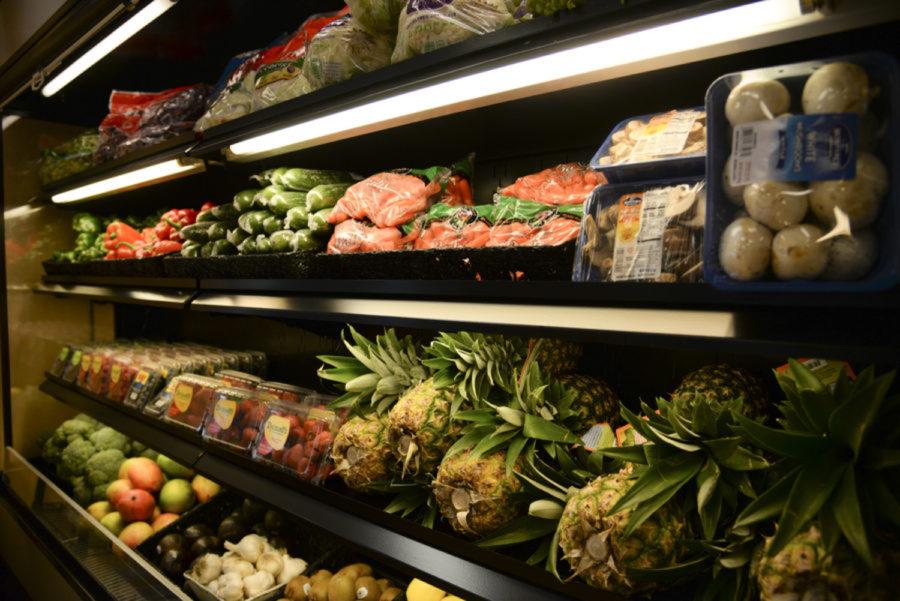Opinion | Central Oakland has a food accessibility problem
Fruits and vegetables on shelves at Forbes Street Market.
March 4, 2022
With its restaurant-lined streets, most people would not consider Central Oakland to be a food desert. But when it comes to relatively affordable restaurant and grocery options, the area is severely lacking, and this has a lot to do with the student presence there.
Pitt owns the only grocery store on campus, Forbes Street Market, and its prices are ridiculously inflated. When I visited, a regular-sized box of Lucky Charms cereal was market $6.89 at Forbes, compared to Target, where it costs $3.49. A singular banana costs $1.09 at Forbes, compared to Giant Eagle, where a pound of bananas costs $0.59.
The closest grocery stores — Target, Giant Eagle, Aldi and Trader Joe’s — are no short trip away. For Oakland residents who don’t have Panther cards, this means shelling out $2.75 for the bus each way or long walks toting grocery bags. This leaves many relying on nearby drugstores such as Rite Aid and CVS for groceries, which is not ideal, since they are nowhere close to a full service stop for food.
The restaurants themselves leave something to be desired. Central Oakland is overrun with chain restaurants such as Dunkin’, Roots, Piada, Panera, Chipotle, Subway, Moe’s Southwest Grill, McDonald’s and more. Viva Los Tacos, Stack’d and CHiKN are actually all owned by the same restaurant group.
Meals at these places will usually cost about $10-12, and it’s not always easy to find healthy options. Interestingly, many restaurants in Oakland offer food that would be easy for students to make themselves — if only they had more stoves or ovens in their dorms, or access to affordable groceries.
Finding food may not seem like a huge problem for Pitt students who have meal plans. There are multiple dining halls and even more on-campus restaurants. But the meal plans themselves are not the most affordable. First-year students who live in residence halls are required to purchase meal plans with unlimited meal swipes, which happen to be the most expensive options offered, ranging from $2,115 to $2,730.
And then there’s dining dollars. Many students opt for dining dollars because they can use them at local restaurants — which I’m convinced is the only reason some of these places are still open. They can also pick up drinks, sandwiches and snacks at any of the University’s bodegas.
Something strange happens when students pull out their Panther cards to pay. It’s as if students forget that it’s their money that paid for that meal plan and, subsequently, that $6 bag of Cheez-Its. If I had a dining dollar for every time a friend wanted to go to the Market at Towers because “it’s not real money,” I would have a lot of dining dollars, but I still probably wouldn’t be able to buy much.
This gets to the heart of the problem — that Oakland is set up like a college campus, but not all of its residents are college students. A 2012 report from the University Center for Social and Urban Research found that around 74% of Central Oakland residents are between the ages of 18 and 24. Around 37% of South Oakland residents are between the ages of 18 and 24.
West, South and Central Oakland have all seen a gradual decline in resident population since the 1950s. This will only be exacerbated as Carnegie Mellon University and Pitt’s class sizes and campuses seem to expand. Calls for more residential, affordable housing and a grocery store have been made by community members for years.
And it’s not as if Pitt students are able to pay this much for food, either. That same report showed that about 66% of Central Oakland residents live under the poverty threshold. The average Pitt student accumulates about $40,000 worth of debt.
But the food problem in Oakland is much more complex than it appears. There is not only a lack of affordable food options, there’s also a significant amount of food waste. Perhaps students should have more selective meal plan options, given that Pitt’s largest dining hall, The Eatery, wastes nearly 1,000 pounds of edible food each day.
Furthermore, depending on who is involved in the planning, putting a grocery store in Oakland could hurt more than help. Pitt announced its plans this summer to redevelop one of its properties, 3401 Boulevard of the Allies, into a grocery store and non-student housing. Just what we all wanted, right?
Well, Pitt chose to partner with Walnut Capital on the project, a private developer that specializes in apartments across the City, and so far, I don’t think the plans have been very community centered. Their Oakland Crossings proposal means rezoning parts of Central and South Oakland, including McKee Place, Boulevard of the Allies and Halket Street, to make space for a grocery store and high density “walk to work” housing.
During a City Planning Commission meeting in December, Andrew Dash, director of the Department of City Planning, shared concerns about the lack of community input and specific affordable housing mechanisms, as well as its seeming failure to include the Department of City Planning in the drafting process. The arrival of grocery stores to neighborhoods can also mean rent spikes, displacement and the disappearance of small businesses.
While this proposal may seem like a solution to Oakland’s housing and grocery store problem, it has the ability to be harmful. As students, we are part of the reason Oakland has changed so much. It is our responsibility to advocate with residents for inclusionary zoning, equitable development, and proposals that involve business owners, residents and public servants.
India is The Pitt News’ informed rebel girl. Write to her at [email protected] or follow her on Twitter @indialarson_, but you better like her tweets.









